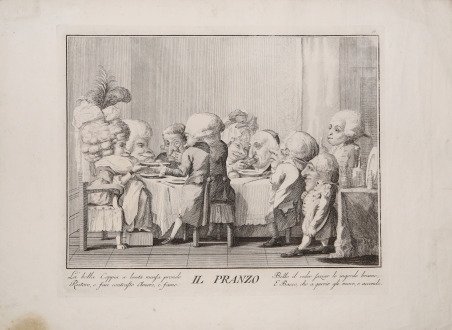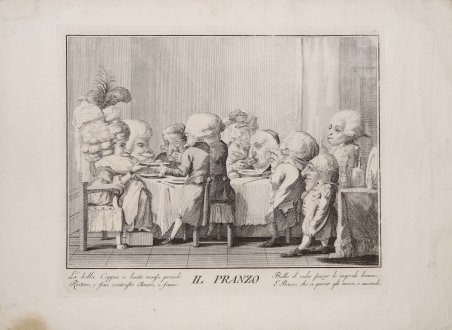Acquaforte, 1791/95, priva di firma ed indicazioni editoriali. Da un soggetto di Giuseppe Piattoli. Bellissima prova, impressa su carta coeva, con margini, in ottimo stato di conservazione. Tavola della serie ' Lo Sposalizio di Marfisa, una serie di 10 opere incise da Carlo Lasinio su disegno di Giuseppe Piattoli e pubblicate a Firenze dalla tipografia di Niccolò Pagni e Giuseppe Bardi. Per la datazione delle stampe, sia Lazzaro che Scrase - analizzando gli esemplari conservati al Cantor Arts Center - propongono il 1790 basandosi, forse, sulla data della tavola intitolata “La buona notte”, l’unica in cui l’ultima cifra sembra essere uno zero. Tuttavia, l’assenza della serie di Marfisa nell’elenco delle opere in vendita in un altro ' Catalogo delle stampe incise in rame che si vendono in Firenze da Niccolò Pagni, e Giuseppe Bardi ' stampato a Firenze dopo il 1791, avvalora l’ipotesi di una datazione seguente a questa data poiché risulterebbe inconsueta la mancata promozione di una raccolta edita soltanto l’anno precedente. In un successivo catalogo della tipografia conservato nella Raccolta Bertarelli, troviamo citato “Lo sposalizio di Marfisa, o sia raccolta di Caricature diverse inventate da Giuseppe Piattoli in Num. 10 mezzi fogli imperiali, ed espresse a colori. Paoli 15”. Le dieci incisioni - mai rilegate e prive di frontespizio - accompagnate da iscrizioni di titolazione e documentarie, costituiscono un vero e proprio poemetto figurato con i momenti chiave che preludono a un matrimonio alla moda settecentesca, i cui eleganti versi stridono, volutamente, con i personaggi grotteschi ai quali si riferiscono, accentuandone il carattere ridicolo. La vasta letteratura satirica e burlesca di tradizione toscana, insieme alle poesie e canzoni popolari, ispirano certamente il Piattoli, al quale doveva essere nota la produzione del poeta Francesco Berni, vissuto due secoli prima, dal quale deriva il termine “bernesco” per definire un vero e proprio genere letterario, che ebbe numerosi imitatori e influenzerà anche la pittura caricaturale a cavallo tra Sei e Settecento. Altra fonte di ispirazione, fu il poema eroicomico, intitolato ' La Marfisa Bizzarra, composto da Carlo Gozzi tra il 1761 e il 1768, il quale offre al pubblico una stravagante versione del mondo epico-cavalleresco. Per quanto riguarda, invece, le fonti grafiche e pittoriche utilizzate dall’artista se ne possono suggerire molteplici e di diversa provenienza: quella anglosassone - soprattutto la famosa serie realizzata da William Hogarth, tra il 1743 e il 1745, dal titolo ' Mariage à la mode; quella veneta - motivi satirici e scherzosi del costume veneziano caratterizzano le incisioni di Giandomenico Tiepolo, che ritraggono scene di vita quotidiana; quella romana, dove l’abbondante produzione caricaturale di Pier Leone Ghezzi era all’epoca tra le più diffuse, e non ultima la tradizione toscana, i cui personaggi deformi saranno tra i soggetti preferiti della pittura di genere dal Cinquecento al Settecento. Sarà però l’incisore lorenese Jacques Callot, arrivato nel 1611 a Firenze, a creare con i suoi ‘Gobbi’ una tipologia caricaturale che influenzerà non solo le opere di artisti a lui coevi come Stefano Della Bella e Baccio del Bianco, ma anche quelle del bresciano Faustino Bocchi e di Giovanni Domenico Ferretti, rievocanti in alcuni tratti le affascinanti grottesche di Gaetano Piccini, i cui personaggi - i cosiddetti caramogi - sono gli stessi che popolano ' Lo Sposalizio di Marfisa. Piattoli attinge, dunque, a piene mani da questi repertori traendo ispirazione soprattutto dai disegni di Baccio, nonostante siano tra quelli meno conosciuti poiché non tradotti in incisione. Per il Piattoli le ‘Nozze di Marfisa’ non sono altro che il pretesto per deridere benevolmente l’ingenuo e coinvolgente sentimento amoroso della fanciulla desiderosa di percorrere tutte le fasi convenzionali che preludono al matrimonio, a cominc. Etching, 1791/95, unsigned and without printing details. From a subject by Giuseppe Piattoli. Beautiful proof, impressed on contemporary wove paper, with margins, in excellent condition. Plate from the series ' Lo Sposalizio di Marfisa, a series of 10 works engraved by Carlo Lasinio from a drawing by Giuseppe Piattoli and published in Florence by the printing house of Niccolò Pagni and Giuseppe Bardi. For the dating of the prints, both Lazarus and Scrase -analyzing the examples preserved at the Cantor Arts Center - propose 1790 based, perhaps, on the date of the panel titled "La buona notte," the only one in which the last figure appears to be a zero. However, the absence of the Marfisa series in the list of works for sale in another ' Catalogo delle stampe incise in copperplate che si vendono in Firenze da Niccolò Pagni, e Giuseppe Bardi ' printed in Florence after 1791, supports the hypothesis of a dating after this date since it would be unusual for a collection published only the previous year not to be promoted. ' In a later catalog of the printer preserved in the Bertarelli Collection, we find the series listed as "Lo sposalizio di Marfisa, o sia raccolta di Caricature diverse inventate da Giuseppe Piattoli in Num. 10 mezzo fogli imperiali, ed espresse a colori. ' 15 Pauls." The ten engravings, lacking a frontispiece, constitute a veritable figurative poem with the key moments that prelude an eighteenth-century fashionable wedding, whose elegant verses deliberately clash with the grotesque characters to whom they refer, accentuating their ridiculous character. The vast satirical and burlesque literature of the Tuscan tradition, together with popular poems and songs, certainly inspired Piattoli, to whom the production of the poet Francesco Berni, who had lived two centuries earlier, must have been familiar, from whom the term "bernesco" was derived to define a true literary genre, which had numerous imitators and would also influence caricature painting at the turn of the seventeenth and eighteenth centuries. Another source of inspiration, was the heroicomic poem, entitled ' La Marfisa Bizzarra, composed by Carlo Gozzi between 1761 and 1768, which offered the public an extravagant version of the epic-chivalric world. As for, on the other hand, the graphic and pictorial sources used by the artist, one can suggest multiple ones of different origins: the Anglo-Saxon one - especially the famous series created by William Hogarth, between 1743 and 1745, entitled ' Mariage à la mode; the Venetian one - satirical and playful motifs of Venetian costume characterize Giandomenico Tiepolo's engravings, which depict scenes of everyday life; that of Rome, where Pier Leone Ghezzi's abundant caricature production was among the most widespread at the time; and last but not least the Tuscan tradition, whose deformed characters would be among the favorite subjects of genre painting from the 16th to the 18th century. It would be, however, the Lorraine engraver Jacques Callot, who arrived in Florence in 1611, who would create with his 'Gobbi' a caricature typology that would influence not only the works of contemporary artists with him, such as Stefano Della Bella and Baccio del Bianco, but also those of the Brescian Faustino Bocchi and Giovanni Domenico Ferretti, evoking in some features the fascinating grotesques of Gaetano Piccini, whose characters - the so-called caramogi - are the same ones who populate ' Lo Sposalizio di Marfisa. Piattoli draws, therefore, heavily from these repertoires, drawing inspiration mainly from Baccio's drawings, despite the fact that they are among the least known since they are not translated into engravings. For Piattoli, the 'Marriage of Marfisa' is nothing more than a pretext to benevolently mock the naïve and engaging love feeling of the eager maiden through all the conventional stages that prelude marriage, beginning precisely with the "Marriage Sign," which officially sanctions the union with the. Cfr.


Scopri come utilizzare
Scopri come utilizzare

